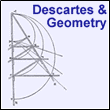forum
library
tutorial
contact

Warren and the Geometrical Approach to i
by Caspar Wessel, Jesper LutzenWessel Symposium at The Royal Danish Academy of Sciences and Letters,
Copenhagen August 11 - 15, 1998
|
the film forum library tutorial contact |

|
Warren and the Geometrical Approach to iby Caspar Wessel, Jesper LutzenWessel Symposium at The Royal Danish Academy of Sciences and Letters, Copenhagen August 11 - 15, 1998 |
Section 5 Warren and the Geometrical Approach
The earliest hint at the possiblity of a two-dimensional representation of complex numbers was in John Wallis's Treatise of Algebra of 1685. There, he had demonstrated a procedure for determining the real coefficients of the complex roots of quadratic equations, by means of two perpendicular axes, one for the reals and one for the imaginaries -- although this latter was not necessarily the y-axis. [Wallis 1685, 266-73] However, while correct, Wallis's method, and others formulated during the 18th century, failed either to exert any influence on further developments or to persuade the mathematical community of the validity of complex numbers.
Thus, despite is great merit, when the Norwegian Caspar Wessel (1745-1818) published his paper "On the analytic representation of direction" in 1799, it received virtually no attention until its republication nearly a ...
... p.161 is not revealed in Google Books preview, as this book is under copyright, so please visit Google Books and click on Get this Book.
Warren's A Treatise on the Geometrical Representation of the Square Roots of Negative Quantities thus gave the most comprehensive rationale to date (in English) for the geometrical representation of complex numbers; and whil there were omssions, it was praised for having "completely succeeded in giving an interpretation of the roots of unity, when attached to symbols which denote lines in Geometry" [Peacock 1830, xxvii)]
The work of John Warren, though virtually unheard of outside Britain, and largely forgotten within twenty years inside, was otherwise significant in two respects. Firstly, it would later influence Hamilton in his research on algebraic triples and hence provide a starting point from which the theory of quaternions would develop. Secondly, it markes the genesis of a change in attitude amongst British mathematicians -- an attitude completely shared by Peacock -- in which the justification of complex numbers is only part of a broader framework which is more concerned with how mathematics can be extended once their use is permitted.
Indeed, if anything, Warren's work was less an attempt to justify "impossible" numbers than a bid to demonstrate their geometric utility. In fact he rarely used the word "impossible" to describe comples numbers, since "by the word 'impossible' no impossibility is necessarily implied, but on the contrary, .... the quantitites called impossible have a real existence, and are capable of geometric representation". [Warren 1829b, 340] This progressive attitude characterised much of British work on complex numbers from this point onwards. In British eyes, thanks to Warren and Peacock, the veracity of their use in both algebra and geometry was now established. The question now was to discover in what ways the subject could be extended. The first area considered was that of logarithms.
...
From Wikipedia
Caspar Wessel (June 8, 1745 - March 25, 1818) was a Danish-Norwegian mathematician.
Wessel was born in Jonsrud, Vestby, Akershus, Norway. In 1763, having completed secondary school, he went to Denmark for further studies (Norway having no university at the time). In 1778 he acquired the degree of candidatus juris. From 1794, however, he was employed as a surveyor (from 1798 as Royal inspector of Surveying).
It was the mathematical aspect of surveying that led him to exploring the geometrical significance of complex numbers. His fundamental paper, Om directionens analytiske betegning, was published in 1799 by the Royal Danish Academy of Sciences and Letters. Since it was in Danish, it passed almost unnoticed, and the same results were later independently found by Argand and Gauss.
Wessel's priority to the idea of a complex number as a point in the complex plane is today universally recognised. His paper was re-issued in French translation in 1899, and in English in 1999 as On the analytic representation of direction (ed. J. Lčtzen et al.).
Wessel's elder brother Johan Herman Wessel was a major name in Danish-Norwegian literature.
learn more on topics covered in the film
see the video
read the script
learn the songs
discussion forum
